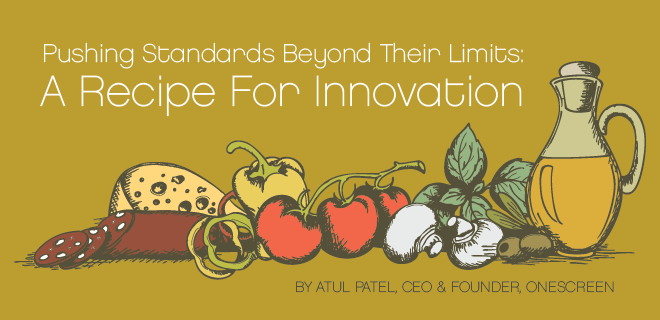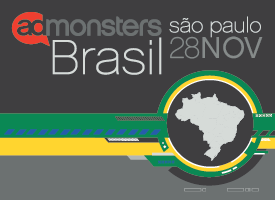
There can be a tendency to confuse “standards” with over-simplification in advertising and media. Companies in the IAB Digital Video Committee (in which my company, OneScreen, participates) come together to create standards that reasonably accommodate the industry’s current needs based on their respective business and technical requirements. With standards adoption becoming more widespread, we would expect to see more businesses utilizing them to launch into new areas of innovation.
Instead, the usual outcome often leads the industry towards “common denominator” scenarios with the same creative implementation ending up everywhere. It doesn’t have to (and shouldn’t) be this way. IAB’s VSuite provides advertisers and even producers and publishers with the frameworks for implementing creative solutions into standards that attract, inform, and engage with much less effort than before.
Don’t get me wrong. The limited amount of innovation taking place does not mean these standards are harmful. Standards are necessary and have served an important purpose of streamlining industry complexities and enabling more companies to participate in the ecosystem.
Tremor Media, YuMe Networks and FreeWheel – founded before the IAB standards in 2005, 2006, and 2007, respectively – have proprietary player plug-ins that are required to be implemented by their clients. If a publisher wants to work with more than one of these vendors for different services, their developers are required to integrate each plug-in, putting a heavy burden on their clients. Those and other proprietary plug-ins live on to this day, and some provide significant value that makes the implementation worthwhile, such as Google’s IMA3.
On the other hand, Brightroll and Undertone gained momentum by adapting to the standard, which made their services more accessible and put Brightroll near the top of the video ad network list. FreeWheel has joined the success of standards adoption and announced early September that it had begun integrating VAST and VMAP into its core products. By incorporating IAB’s VSuite standards into their services, vendors make it easier for publishers to use their services across all properties and platforms consistently.
While this does democratize some business models that depended on proprietary plug-ins, it’s also the natural evolution of the media and advertising market. These companies will stay competitive if they provide more value than a proprietary language, form or plug-in.
More Than Democratization
If standards are really meant to serve the industry, they must be used for more than just democratization. An unfortunate side effect of standards adoption has been that many in the industry have not gone beyond utilizing their simplest form. How often do you see anything more than a linear video ad with a standard 300×250 companion banner?
Although the IAB’s VSuite provides the framework for advertisers, producers, and publishers to build innovation into their use of standards, the easiest path is usually what is settled for because it requires the least amount of work. The lackluster use of these standards may be a matter of the work and time it took companies to transition to using the standard.
But now that VAST has become the universal language for digital video advertising, there is no excuse for not moving forward with innovation and creativity. The new IAB VSuite makes doing so very feasible, allowing for even greater control and flexibility. For example, publishers are able to showcase multiple ads in a row using VAST 3.0 ad pods, call ads at specific times in a video using VMAP, and display event-based ads using VPAID (which has existed for a while).
The possibilities are endless if companies will only tap in to the flexibility that VSuite offers. Some advertising platforms are already embarking on this type of innovation such as Innovid and Brainient, which use VPAID units to create interactions with users through forms, survey polls, social media, exclusive content, and more.
Others, like Google with their TrueView Video Ads ad selector format (available through their IMA3 SDK plug-in) are leveraging standards to allow more engagement through user choice. OneScreen (the company I work for) has helped its clients enrich the experience for brands with OneVoice, an ad creative that uses VAST to fill all ad units on a page, including each banner ad and the page background. More innovations like these are surely on the horizon.
Democratization is a double-edged sword. On one hand, having more entrants in the market, creates pricing efficiencies through competition, enforces vendor accountability, and even endorses more creativity. On the other, it can create a lot of noise with new vendors coming into the market that solely rely on what standards enable them to offer.
For instance, there is now a proliferation of second-tier video ad networks that are just distributing VAST tags sourced from first-tier ad networks and “wrapping” (a standards’ term) those tags to make it seem like they are bringing real value to their publishers. The same goes with VPAID units that are being used to distribute branded entertainment paid on a CPV, almost all using YouTube’s Chromeless video player. These services should exist, but with so many “feature” companies it only leads to confusion for advertisers and even publishers.
A Prime Analogy
In closing, let’s use the evolution of mobile phone chargers and accessories as a case in point. Apple used their own standard “plug” design across all of their products, and this provided enough consistency for innovation to take place within their brand. Soon there were thousands of creative and useful accessories for iPods, iPhones, and iPads. While Apple is big enough to push their own proprietary format, all other manufacturers had special chargers and connectors for each of their products, which made innovation difficult for accessories providers.
Since then, these manufacturers have transitioned to mostly microUSB, creating consistency for consumers while enabling innovation and creativity in the accessories market. We are now at a similar stage in digital video. Of course, companies with massive scale will have the flexibility to do as they please, but with standards available for the rest of the fragmented market, focus can be placed on what matters – innovating and enhancing the audience experience without bending over backwards to do it.
 |
The Brazilian digital advertising scene is heating up – AdMonsters Brazil will bring digital advertising leaders and ops professionals together to discuss and develop best practices for the budding Brazilian online ad infrastructure. Register today for AdMonsters Brazil, which will be held Nov. 28, 2012, in São Paulo. |